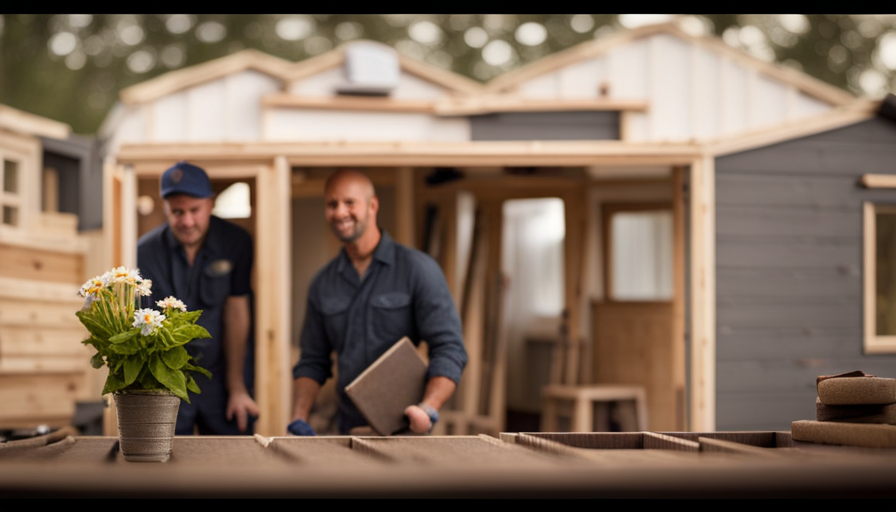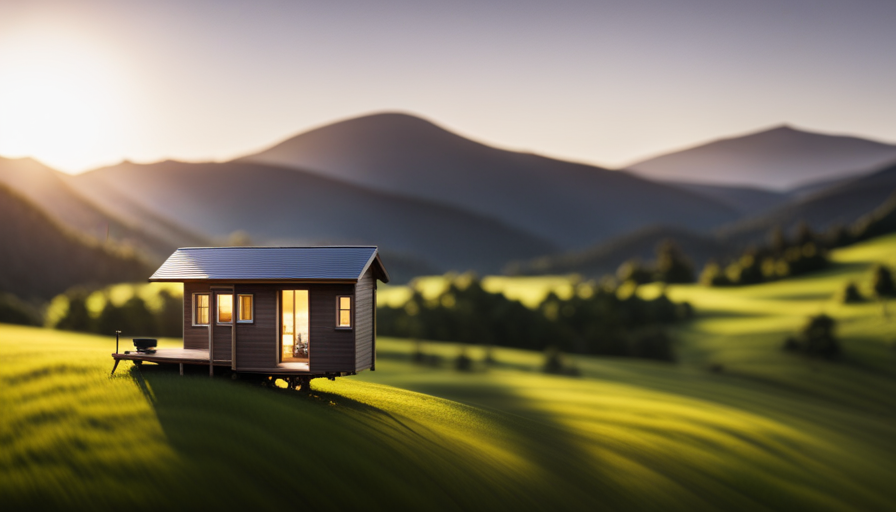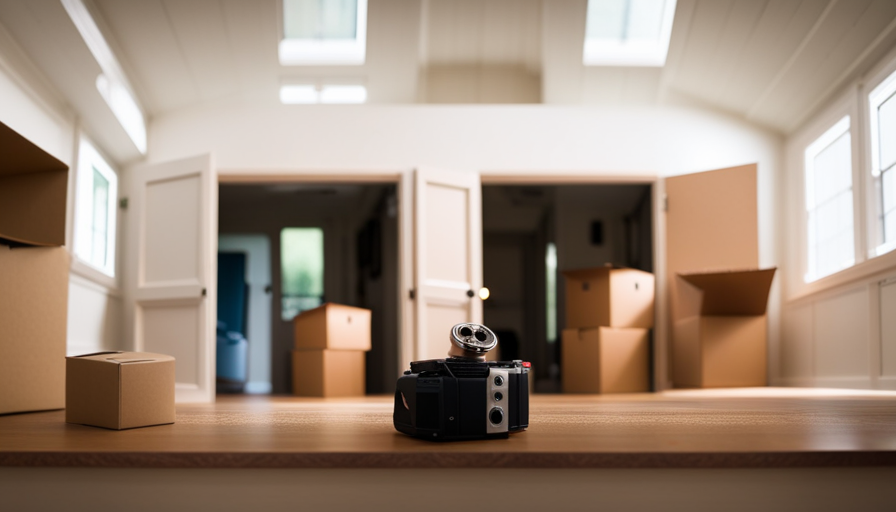Picture a cozy, charming corner that feels like home to you. It’s a space where comfort meets functionality, enabling you to live comfortably while also maintaining your budget.
Building a tiny house cheap may seem like an impossible feat, but I’m here to tell you that it can be done. With the right knowledge, tools, and a dash of creativity, you can create your very own affordable tiny house.
In this article, I will guide you through the process, sharing practical tips and tricks that will help you keep costs to a minimum while still achieving your dream home. From setting a budget and researching materials, to utilizing recycled materials and optimizing space design, I’ll show you how to make every penny count.
So, let’s dive in and discover the secrets to building a tiny house that’s not only affordable, but also a true reflection of your unique style and personality.
Key Takeaways
- Set a budget and stick to it to avoid overspending.
- Research and compare costs for materials and tools to find the best deals.
- Utilize alternative construction techniques and materials to save costs.
- Maximize space efficiency and opt for DIY to reduce overall building costs.
Set a Budget and Stick to It
You need to set a budget and stick to it if you want to build a tiny house cheap. This is the first and most important step in ensuring that you don’t overspend or go overboard with unnecessary expenses.
To stick to a budget, it’s crucial to prioritize essential features and determine what you truly need versus what you want. This will help you make informed decisions and avoid splurging on luxury items that can significantly increase costs.
Start by listing down the must-haves for your tiny house, such as the number of rooms, energy-efficient appliances, and storage space. Once you have a clear idea of what you need, allocate a specific amount of money to each category. This will prevent overspending and allow you to set realistic expectations. Remember, building a tiny house cheap doesn’t mean compromising on quality; it means being smart and resourceful with your choices.
Now, let’s transition into the next section, which involves researching and comparing costs for materials and tools. By doing thorough research, you can find the best deals and identify cost-effective alternatives without sacrificing quality.
Research and Compare Costs for Materials and Tools
When it comes to creating your cozy abode, it’s important to do some research and compare the costs of the materials and tools needed. Comparing prices and researching deals can help you find the best deals and save money while building your tiny house.
One way to do this is by visiting local hardware stores and comparing prices for the materials you need. Don’t forget to check online retailers and wholesalers as well, as they often offer competitive prices and discounts.
Additionally, consider attending home improvement expos or trade shows where you can find special deals and discounts from various vendors. Another useful strategy is to join online forums or social media groups dedicated to DIY home building, where members often share tips and recommendations for affordable materials and tools.
By being diligent in your research and comparison, you can find the best prices and deals for the materials and tools needed for your tiny house project. With this knowledge, you can then transition into considering alternative building methods in the subsequent section, exploring options that can further reduce costs and make your tiny house dream a reality.
Consider Alternative Building Methods
Consider exploring alternative construction techniques that can significantly lower the overall cost of your small living space, such as using recycled materials, which can reduce expenses by up to 50%. When it comes to building a tiny house cheaply, it’s important to think outside the box and consider different options. Alternative construction techniques can be a game-changer in terms of affordability.
One cost-effective building method to consider is using alternative materials. Instead of traditional lumber, you can use recycled or reclaimed materials such as shipping containers, pallets, or even old barn wood. These materials can often be obtained for little to no cost and can give your tiny house a unique and rustic charm.
Another alternative construction technique is to utilize innovative building systems. For example, instead of using traditional stick framing, you could explore the option of using structural insulated panels (SIPs) or insulated concrete forms (ICFs). These systems are not only cost-effective but also provide excellent insulation, making your tiny house energy-efficient and reducing long-term expenses.
By considering alternative construction techniques and cost-effective building materials, you can significantly reduce the overall cost of building your tiny house. In the next section, we will delve into the benefits of utilizing recycled and reclaimed materials, which can further enhance the affordability and sustainability of your project.
Utilize Recycled and Reclaimed Materials
Explore the exciting world of utilizing recycled and reclaimed materials to add character and charm to your small living space. When it comes to sourcing recycled materials, the possibilities are endless. You can visit salvage yards, thrift stores, and even online marketplaces to find unique pieces that will give your tiny house a one-of-a-kind look. Don’t be afraid to think outside the box and get creative with your upcycling techniques.
Here are three ideas to get you started:
-
Repurpose old pallets: Pallets can be transformed into everything from furniture to wall paneling. With a little sanding and staining, you can create a rustic and eco-friendly addition to your tiny house.
-
Salvage doors and windows: Give your tiny house a touch of history by incorporating salvaged doors and windows. Not only will they add character, but they can also save you money compared to buying new.
-
Upcycle shipping containers: Shipping containers are a popular choice for tiny house builders. Not only are they readily available, but they also offer a unique and modern aesthetic. With a little creativity, you can turn these industrial containers into a comfortable and stylish living space.
By utilizing recycled and reclaimed materials, you can create a tiny house that’s not only affordable but also environmentally friendly. Now that you have some ideas for incorporating these materials, let’s explore how to optimize space design and layout to make the most of your tiny living area.
Optimize Space Design and Layout
To maximize your small living area, think strategically about space design and layout. When building a tiny house, every square inch counts, so it’s crucial to make the most of the available space.
One effective way to optimize your tiny house is by using space-saving furniture. Look for multi-functional pieces that can serve multiple purposes, such as a sofa that can be converted into a bed or a dining table that can be folded down when not in use. These furniture options will help you make the most of your limited space without sacrificing comfort or convenience.
Another key aspect to consider is maximizing vertical space. Take advantage of the height of your tiny house by incorporating storage solutions that go upwards. Install shelves or cabinets that reach all the way to the ceiling, allowing you to store items that are not frequently used. You can also use wall-mounted organizers or hooks to keep things off the floor and create a clutter-free environment.
By carefully planning your space design and layout, incorporating space-saving furniture, and maximizing vertical space, you can create a tiny house that feels spacious and functional.
In the next section, we will explore the importance of DIY projects in building a tiny house on a budget.
DIY as Much as Possible
When it comes to building a tiny house, it’s important to optimize every inch of space. As mentioned in the previous subtopic, space design and layout play a crucial role in maximizing efficiency. But there’s another aspect that can significantly reduce costs: DIY.
By taking on as much of the construction process as possible, you can save a considerable amount of money. DIY allows you to be in control of every aspect of your tiny house build. From framing and insulation to plumbing and electrical work, there are numerous resources available that provide step-by-step instructions and guidance. Not only does this give you the opportunity to personalize your space according to your needs and preferences, but it also eliminates the need for hiring expensive contractors.
Additionally, DIY opens up the possibility of using cost-effective alternatives. For example, instead of purchasing brand new materials, you can explore salvage yards or online marketplaces for reclaimed or repurposed items. These can be not only affordable but also add character and uniqueness to your tiny house.
By maximizing efficiency through space design and layout, and by opting for DIY as much as possible, you can significantly reduce the overall cost of building your tiny house.
Now, let’s explore another strategy to save on expenses: taking advantage of sales and discounts.
Take Advantage of Sales and Discounts
Get ready to score some great deals and save money on your tiny house project by taking full advantage of sales and discounts available to you. When it comes to building a tiny house on a budget, every penny counts, and negotiating prices can make a big difference.
Don’t be afraid to ask for a discount or negotiate the price of materials and tools with suppliers. Many times, they’re willing to work with you and offer a lower price.
Another great way to save money is by looking for clearance items. Many stores have a designated clearance section where you can find discounted building materials, furniture, and appliances. These items may have minor imperfections or be discontinued, but they can still be perfectly functional and save you a significant amount of money.
By being resourceful and keeping an eye out for sales and discounts, you can stretch your budget further and make your tiny house dreams a reality. Seek assistance from friends and family who may have connections or know of any upcoming sales. Building a tiny house cheaply is all about being proactive and making the most of the opportunities that come your way.
Seek Assistance from Friends and Family
Don’t hesitate to reach out to your friends and family for support and assistance in making your tiny house dreams a reality. Building a tiny house can be a daunting task, both financially and physically. However, by enlisting the help of your loved ones, you can save money and make the process more enjoyable.
Collaborating with others not only lightens the workload but also allows you to tap into their expertise and skills. When seeking assistance from friends and family, you can divide the tasks based on their strengths and interests. For example, if your cousin is a skilled carpenter, they can help with framing and construction, while your aunt who loves gardening can help with landscaping.
By spreading out the workload, you can save money on hiring professionals and also strengthen your bond with your loved ones. Moreover, your friends and family may have connections with suppliers or know where to find discounted building materials. They can help you navigate through sales and discounts, ensuring you get the best deals and save money along the way.
In the next section, we will discuss how to prioritize essential features and eliminate unnecessary expenses to further optimize your tiny house budget. With the support of your loved ones and some strategic planning, you’ll be well on your way to building a tiny house that meets your needs and fits your budget.
Prioritize Essential Features and Eliminate Unnecessary Expenses
To make the most of your budget, it’s important to prioritize the must-haves and cut out any unnecessary expenses in your tiny home project. When building a tiny house on a tight budget, it’s essential to focus on budget-friendly designs and creative storage solutions. By incorporating these elements, you can build a comfortable and functional tiny home without breaking the bank.
One way to save money is by designing a simple and compact layout. Consider using an open floor plan to maximize space and eliminate the need for unnecessary walls. Additionally, opt for multi-purpose furniture that can serve multiple functions, such as a sofa that can transform into a bed or storage ottomans.
Another cost-saving strategy is to utilize creative storage solutions. Incorporate built-in cabinets and shelves to maximize vertical space and keep your belongings organized. Additionally, consider using under-the-stair storage or loft spaces to store items that you don’t need daily access to.
To visualize the impact of these budget-friendly designs and creative storage solutions, take a look at the table below:
| Essential Features | Unnecessary Expenses |
|---|---|
| Open floor plan | Fancy light fixtures |
| Multi-purpose furniture | Expensive countertops |
| Built-in cabinets and shelves | High-end appliances |
| Under-the-stair storage | Custom window treatments |
| Loft spaces | Luxury bathroom fixtures |
By prioritizing essential features and eliminating unnecessary expenses, you can build a tiny house that meets your needs while staying within your budget. In the next section, we will discuss how to plan for long-term cost savings in your tiny home project.
Plan for Long-Term Cost Savings
Maximize your savings and ensure long-term affordability by carefully planning for cost-effective solutions in your tiny home project. When it comes to building a tiny house cheap, it’s important to think about the long-term investment and focus on cost-effective construction techniques.
Here are four key strategies to help you save money in the long run:
-
Energy-efficient design: Incorporating energy-efficient features such as insulation, double-glazed windows, and solar panels can significantly reduce your long-term energy costs.
-
Sustainable materials: Opt for sustainable and durable materials like recycled wood, bamboo flooring, or reclaimed bricks. These materials not only save money but also have a positive impact on the environment.
-
DIY approach: Taking a do-it-yourself approach can save you a significant amount of money. From building your own furniture to installing plumbing and electrical systems, doing it yourself can be a cost-effective way to complete your tiny house.
-
Proper maintenance: Regular maintenance is crucial to prevent costly repairs and ensure the longevity of your tiny house. Simple tasks like cleaning gutters, checking for leaks, and maintaining the HVAC system can save you money in the long run.
By implementing these cost-effective construction techniques and focusing on long-term savings, you can build a tiny house that is affordable and sustainable for years to come.
Frequently Asked Questions
How much money should I set aside for building a tiny house?
When it comes to budgeting for building a tiny house, it’s important to consider cost-effective building techniques. By implementing smart strategies, you can make the most of your money.
To give you an idea, setting aside around $20,000 to $30,000 should be a good starting point. However, this can vary depending on factors like size, location, and materials used.
Keep reading for some budgeting tips and cost-effective building techniques to help you save even more.
What are the average costs of materials and tools needed for building a tiny house?
When it comes to building a tiny house, it’s important to consider the average costs of materials and tools. The best sources for these can vary, but it’s worth checking out local hardware stores, online marketplaces, and even salvage yards for discounted options.
On average, you can expect to spend around $20,000 to $30,000 on materials and tools. However, costs can vary depending on your specific needs and preferences. It’s always a good idea to research and compare prices to get the best deals.
Are there any alternative building methods that can help save money?
Alternative construction techniques and cost-saving building materials can significantly reduce the expenses associated with building a tiny house. By thinking outside the box and utilizing innovative methods, such as using recycled materials or repurposing existing structures, you can save a considerable amount of money.
Additionally, exploring alternative construction techniques like straw bale or earthbag construction can further lower costs while providing a unique and sustainable approach to building your tiny house.
Where can I find recycled and reclaimed materials for my tiny house?
To find recycled and reclaimed materials for your tiny house, start by searching for local recycled materials suppliers in your area. These suppliers often have a wide range of materials available, such as wood, doors, windows, and fixtures.
Additionally, you can try DIY methods for finding reclaimed materials, such as visiting salvage yards, checking online marketplaces, or attending community recycling events. These options can save you money while also giving your tiny house a unique and sustainable touch.
How can I optimize the design and layout of my tiny house to maximize space?
To maximize storage and optimize the layout of your tiny house, there are several creative space-saving techniques you can employ.
Utilize multi-functional furniture like a sofa that doubles as a storage unit, or a bed with built-in drawers. Consider installing wall-mounted shelves and hooks to make use of vertical space. Use foldable tables and chairs to save space when not in use. Think strategically about storage options, such as under-stair storage or utilizing the space above cabinets.
These techniques will help you make the most of your limited space.
Conclusion
As I’m wrapping up this guide on building a tiny house on a budget, I can’t help but feel a sense of accomplishment and satisfaction. It’s like watching a seed grow into a beautiful tree, knowing that you’ve nurtured it every step of the way.
Building a tiny house cheaply requires careful planning, resourcefulness, and a bit of creativity. By following the tips and techniques I’ve shared, you can create a cozy and affordable home that reflects your style and values.
Embrace the journey and enjoy the process of turning your dreams into reality.
Hi, I’m Emma. I’m the Editor in Chief of Tiny House 43, a blog all about tiny houses. While tree houses are often associated with childhood, they can be the perfect adult retreat. They offer a cozy space to relax and unwind, surrounded by nature. And since they’re typically built on stilts or raised platforms, they offer stunning views that traditional homes simply can’t match. If you’re looking for a unique and romantic getaway, a tree house tiny house might just be the perfect option.










